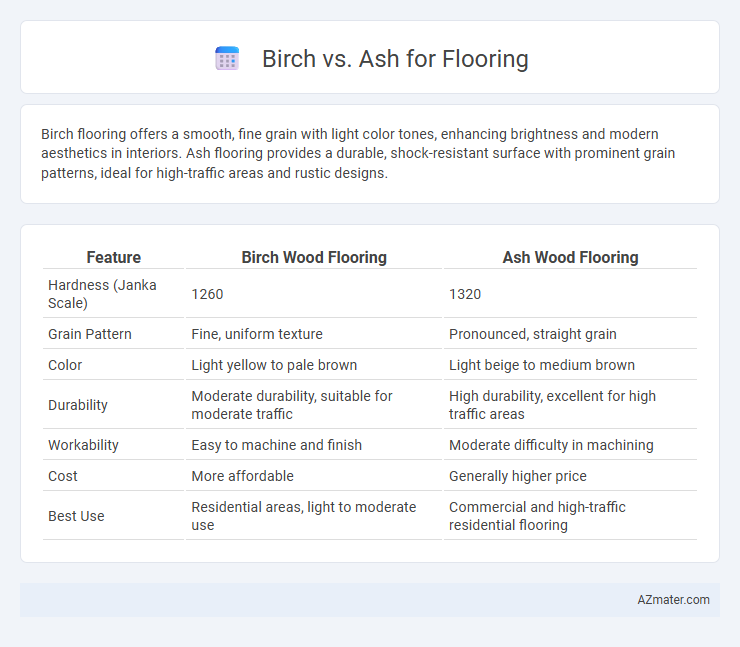Birch flooring offers a smooth, fine grain with light color tones, enhancing brightness and modern aesthetics in interiors. Ash flooring provides a durable, shock-resistant surface with prominent grain patterns, ideal for high-traffic areas and rustic designs.
Table of Comparison
| Feature | Birch Wood Flooring | Ash Wood Flooring |
|---|---|---|
| Hardness (Janka Scale) | 1260 | 1320 |
| Grain Pattern | Fine, uniform texture | Pronounced, straight grain |
| Color | Light yellow to pale brown | Light beige to medium brown |
| Durability | Moderate durability, suitable for moderate traffic | High durability, excellent for high traffic areas |
| Workability | Easy to machine and finish | Moderate difficulty in machining |
| Cost | More affordable | Generally higher price |
| Best Use | Residential areas, light to moderate use | Commercial and high-traffic residential flooring |
Birch vs Ash Flooring: An Overview
Birch flooring offers a fine, uniform grain and light color that enhances modern interiors, while ash flooring features a pronounced grain pattern with a warm, honey-toned hue, adding rustic character. Both hardwoods provide durability suitable for high-traffic areas, with ash typically being harder than birch, making it more resistant to dents and wear. Birch requires regular maintenance to preserve its light appearance, whereas ash's natural toughness and contrasting grain make it easier to mask scratches and imperfections.
Appearance and Color Differences
Birch flooring features a fine, uniform grain with a pale cream to light reddish-brown color, offering a smooth and subtle appearance ideal for contemporary spaces. Ash flooring showcases a more pronounced grain pattern with a natural light beige to medium brown tone, adding warmth and rustic character to interiors. The distinct color variations between birch and ash influence the overall design aesthetic, with birch providing a softer, more neutral palette and ash delivering bolder, contrasting textures.
Durability and Hardness Comparison
Birch flooring offers a Janka hardness rating of approximately 1260, providing moderate durability suitable for areas with light to medium foot traffic. Ash, with a higher Janka hardness rating around 1320, presents greater resistance to dents and wear, making it more durable for high-traffic spaces. Both hardwoods maintain good structural integrity, but Ash's superior hardness ensures longer-lasting performance in demanding environments.
Cost Analysis: Birch vs Ash
Birch flooring generally costs less per square foot compared to ash, making it a more budget-friendly option for homeowners seeking durability and aesthetic appeal. Ash, while typically priced higher due to its distinctive grain patterns and exceptional hardness, offers long-term value through enhanced wear resistance and potential for refinishing. Comparing costs, birch averages $3 to $5 per square foot, whereas ash ranges from $5 to $8, influencing the overall investment depending on flooring area and desired longevity.
Grain Patterns and Texture
Birch flooring features a fine, uniform grain with subtle, linear patterns that create a smooth and consistent texture, ideal for modern and minimalist designs. Ash flooring displays a more pronounced, open grain with distinctive, bold patterns and a coarse texture, adding character and warmth to rustic or traditional interiors. Both hardwoods offer durability, but the choice between birch's subtle elegance and ash's dramatic grain depends on the desired aesthetic impact.
Installation Considerations
Birch flooring offers a fine, uniform grain that allows for easier sanding and finishing, making it suitable for DIY installations. Ash flooring's hardness and open grain require careful acclimation and precise nailing to prevent splitting during installation. Both wood types benefit from professional-grade adhesives and moisture barriers to ensure durability and long-term stability.
Maintenance and Care Requirements
Birch flooring requires regular sweeping and occasional damp mopping to prevent dirt buildup, with periodic refinishing recommended every 7-10 years to maintain its smooth surface. Ash flooring demands similar maintenance but benefits from its natural hardness, making it more resistant to dents and scratches, reducing frequent refinishing needs. Both wood types should be protected from excessive moisture and direct sunlight to preserve their finish and durability over time.
Sustainability and Environmental Impact
Birch flooring offers a sustainable option due to its rapid growth rate and ability to regenerate quickly compared to slower-growing ash trees, which require longer harvest cycles. Ash wood, while prized for its durability and aesthetic, often carries a higher environmental impact because of the extended time needed for mature timber and the risks posed by invasive pests like the emerald ash borer. Choosing birch supports better forest management practices and reduces ecological strain, making it a more eco-friendly choice for environmentally conscious flooring projects.
Best Applications for Each Wood Type
Birch flooring is best suited for high-traffic residential areas due to its durability and fine grain, making it ideal for living rooms and hallways. Ash flooring excels in spaces requiring shock resistance and flexibility, such as gyms or active family rooms, thanks to its strong, elastic properties. Both woods offer distinct advantages, with birch providing a smooth, light finish and ash delivering a bold grain pattern that enhances rustic or modern interiors.
Which Flooring is Right for Your Home?
Birch flooring offers a pale, smooth grain that suits modern and minimalist interiors, providing durability suitable for high-traffic areas. Ash flooring features a pronounced grain pattern and greater hardness, ideal for homes requiring long-lasting resilience against dents and scratches. Choosing between Birch and Ash depends on your aesthetic preference and the level of wear your flooring will endure in daily use.

Infographic: Birch vs Ash for Flooring
 azmater.com
azmater.com